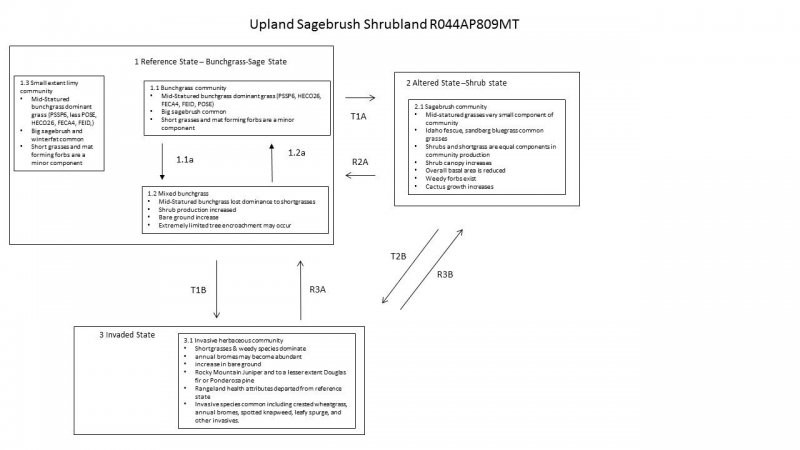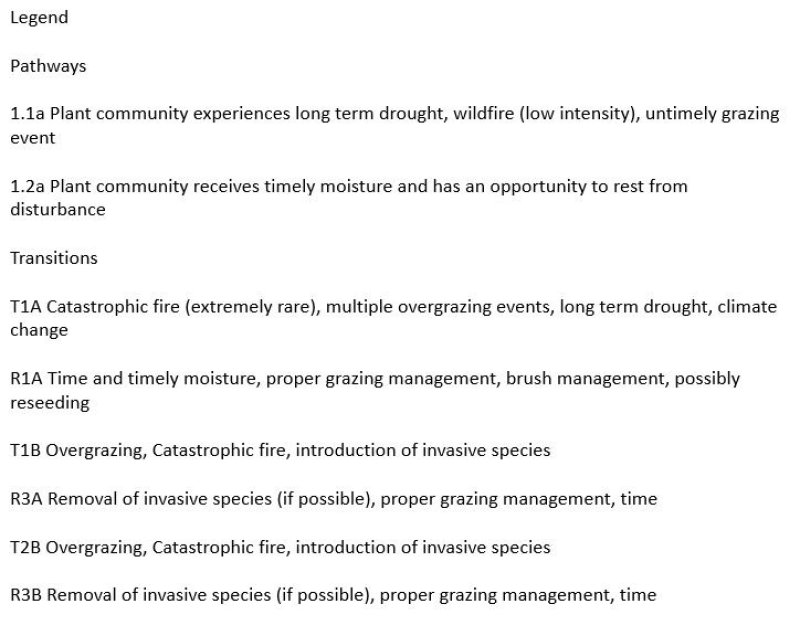
Natural Resources
Conservation Service
Ecological site R044AP809MT
Upland Sagebrush Shrubland Group
Last updated: 9/07/2023
Accessed: 04/20/2025
General information
Provisional. A provisional ecological site description has undergone quality control and quality assurance review. It contains a working state and transition model and enough information to identify the ecological site.
MLRA notes
Major Land Resource Area (MLRA): 044A–Northern Rocky Mountain Valleys
Major Land Resource Area (MLRA): 044A–Northern Rocky Mountain Valleys
This MLRA includes the northern portion of the Northern Rocky Mountain Valleys Province of the Rocky Mountain System. The mountain valleys are deeply dissected and are typically bordered by mountains trending north to south. The nearly level broad flood plains are bordered by gently to strongly sloping terraces and alluvial fans. The surrounding mountains and in some areas the valleys experienced glaciation. The average precipitation is 12 to 16 inches generally, though can vary widely. The dominant soil orders are Inceptisols, Mollisols and Andisols. The valleys support coniferous forests, shrublands and grasslands.
Description of MLRAs can be found in: United States Department of Agriculture, Natural Resources Conservation Service. 2006. Land Resource Regions and Major Land Resource Areas of the United States, the Caribbean, and the Pacific Basin. U.S. Department of Agriculture Handbook 296.
Available electronically at: http://www.nrcs.usda.gov/wps/portal/nrcs/detail/soils/ref/?cid=nrcs142p2_053624#handbook
Ecological site concept
• Site does not receive any additional water
• Site not located in a flood plain
• Dominant Cover: Shrubland/Grassland;Small patch shrub and grassland that is a mix of the two main sagebrush types in Montana; Big sagebrush species are the dominant shrub (Wyoming primarily and at higher elevations Mountain big sagebrush subspecies and green rabbitbrush may be present). Fringed sagewort, cactus and broom snakeweed rare.
Mid-statured bunchgrasses dominant plant type. Bluebunch tends to be the most common however Rough fescue or Idaho fescue, needle and thread, Sandberg bluegrass, Thurber’s needlegrass, prairie junegrass and green needlegrass are possible as mid-statured bunchgrasses. Minor component of forbs (low pussytoes) growing between shortgrasses. Forbs will rarely exceed 10% composition by weight.
• Soils are
o Not saline or saline-sodic
o Not limy
o Moderately deep, deep, very deep
o Not ashy or medial textural family
o Typically less than 15% stone and boulder surface area (<15% max)
• Soil surface texture silt loam to silty clay loam in surface mineral 4”
• Parent material is lacustrine deposits and alluvium
• Drainage class is well drained; no flooding frequency
• Site Landform: lake plains, lake terraces, alluvial fans, fan remnants
• Moisture Regime: ustic/xeric
• Temperature Regime: frigid
• Elevation Range: 2000-4700ft
• Slope: 7-15%
Associated sites
| R044AP808MT |
Upland Grassland Group This associated ecological site resides in areas with deeper soils with less rocks. |
|---|
Similar sites
| R044AP808MT |
Upland Grassland Group This ecological site is similar in that it resides in upland areas, has deep loamy soils, though the amount of rock fragments may be significantly less. Both ecological sites have shrub and perennial grassland species, but this similar ecological site is dominated by grasses while the upland sagebrush ecological site is dominated by sagebrush. |
|---|
Table 1. Dominant plant species
| Tree |
Not specified |
|---|---|
| Shrub |
(1) Artemisia tridentata ssp. vaseyana |
| Herbaceous |
(1) Festuca campestris |
Click on box and path labels to scroll to the respective text.

